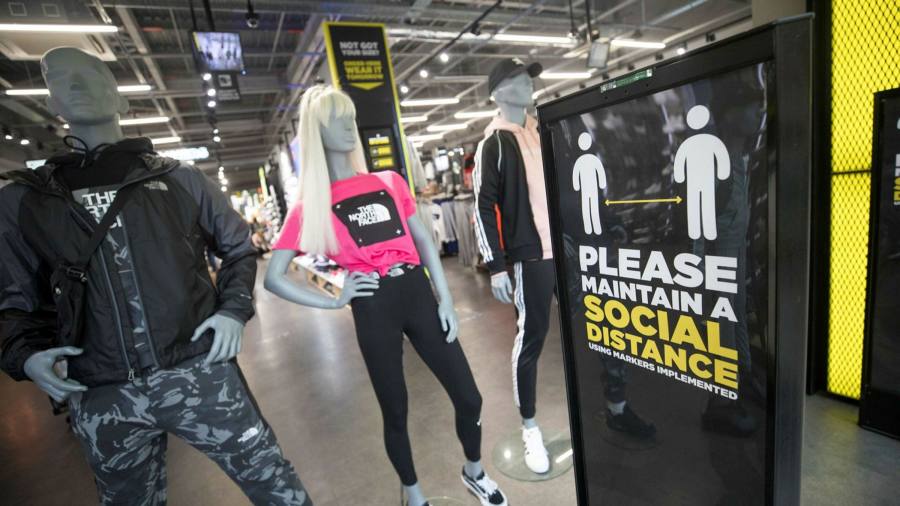[ad_1]
Trying to break America has defeated many UK retailers, but there is no holding back JD Sports. What might the Manchester-based athleisure specialist have that others lacked?
Nike’s Air Jordan 13 Retro Starfish, for one thing. Not that JD Sports can sell them to you now. The $190 white leather and orange suede sneakers sold out last month on the day of release. Getting hold of a pair required visiting a US store in mid-January to pick up a raffle ticket. Drawn names (“selected guestsâ€, the JD Sports website calls them) were invited back by phone call a few days later to make their purchase within a recommended two- to three-hour window.
Artificial scarcity is one of offline retail’s few recent success stories. Nike and Adidas have perfected a formula whereby a handful of favoured retailers hype up some new design or colour combination via blogs and social media, with warnings of tight supply nudging customers into joining a real-world queue. Even in a pandemic, JD Sports has been hosting at least one ticketed sales event in US stores every month. DTLR Villa, the company’s latest acquisition announced on Monday, ran three in December alone.
While these product drops remain a sideline business they help show why JD Sports is racing to build scale in the US. Securing a place in the queue for each new delivery is as important for the retailers as customers.
Big sportswear labels have been choking off third-party chains in recent years as they encourage shoppers to buy directly from themselves. Nike has been leading the push, saying in December that it would “accelerate change with larger undifferentiated accountsâ€.
Wholesalers deliver half the revenue per unit of its digital channels, so Nike is keen to remove those that do little other than leech off its $3bn-plus annual marketing budget. It is then up to a few “strategic partners†— Nike has named JD Sports and Zalando of Germany — to access the markets it cannot reach alone.
Similar arguments can be made for DTLR Villa. The Baltimore-based chain designs its stores to look independent and locally managed, with marketing emphasising strong links to predominantly black communities. It is an opposite to Finish Line, the mall-based group that JD Sports bought in 2018. Adding DTLR will increase JD Sports’ clout and buying power but — similar to its acquisition in December of California boutique Shoe Palace — the benefit is about both demographics and scale.
The most common story of UK retail in the US is one of misunderstood local markets: Tesco, Marks & Spencer, Dixons and Philip Green’s Arcadia all failed because they tried to impose a British way of doing things. JD Sports’ forays stateside hand a lot of control to local management, with DTLR retaining its co-chief executives and Shoe Palace management owning 20 per cent of the US division. It may prove a shrewd strategy.
But with the shares already pricing in success at 25 times current year earnings, more than double sector peers, investors may be acting no more rationally than the sneakerheads.
Flying blind
One of the many perversities of locked-down existence is that those unbelievable TV holiday ads are now believable, writes Matthew Vincent.
Beaches may indeed be unspoilt at the height of the school holidays. Swimming pools could be strangely devoid of bombing teens and inflatables. But for low-cost airline Ryanair, which normally helps 152m people a year ruin such tranquil scenes, Covid flight curbs are also all too real.
Monday’s third-quarter numbers showed it had operated just 30 per cent of its normal flights in the three months to December, at 70 per cent occupancy.
That meant 57 spare seats per average flight — to most passengers, an unbelievable amount of comfort and elbow room. This is not, of course, Ryanair’s idealised vision. Those schedule and load percentages combined to cut revenue in the period by 85 per cent to €177m. The company now forecasts a full-year net loss of up €950m — five times its previous worst in 2009.
Michael O’Leary left no doubt where the blame lay. “The EU now needs to step up the slow pace of its [vaccine] rollout programme to match the UK’s performance,†the Ryanair CEO said before spending Monday putting TV commercials in news interviews.
“We expect to see a very strong return of British families travelling to the beaches of Spain, Portugal, Italy and Greece,†he told the BBC. “We’ll be passing on even lower fares.â€
City Bulletin
Sign up to the City Bulletin newsletter for the latest company news. Every morning our UK equities reporter Bryce Elder covers the biggest business stories and delivers them straight to your inbox by 8am UK time.
He needed to, because burning cash is more costly than not burning jet fuel. Analysts at Liberum noted: “Cash burn was €1bn, which is clearly not sustainable against period end gross liquidity of €3.5bn with looming [€1.5bn] debt maturitiesâ€. But fly 120m predominantly vaccinated people to those beaches, as Ryanair hopes to in the coming year, and the strength of its balance sheet is no longer in doubt.
On top of the cash and a BBB credit rating, about 80 per cent of the fleet is “unencumbered†by charges or lease arrangements and is valued at over €7bn. Funding new aircraft and buying growth should be plain sailing. Investors seem to agree. A 1 per cent share price rise suggests they believe those TV holiday ads will soon be unbelievable again.
JD Sports: bryce.elder@ft.com
Ryanair: matthew.vincent@ft.com
[ad_2]
Source link





